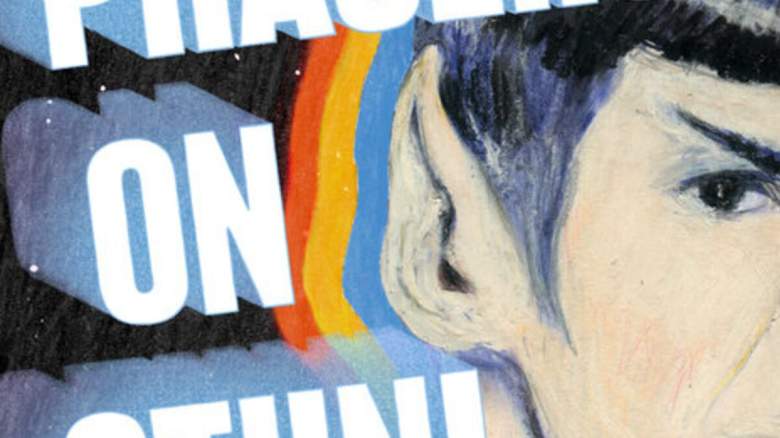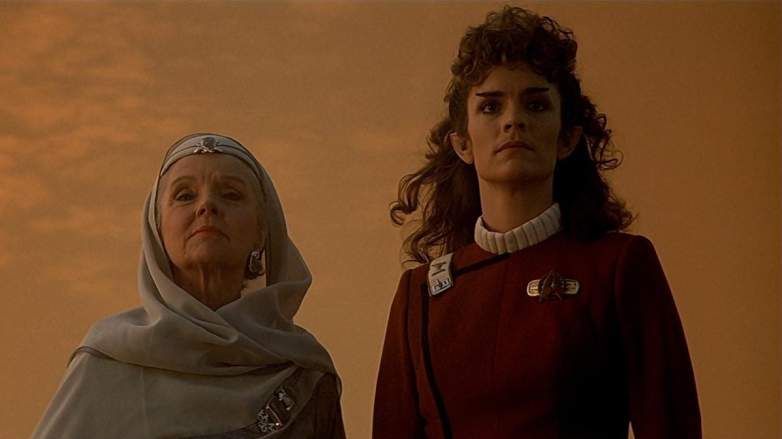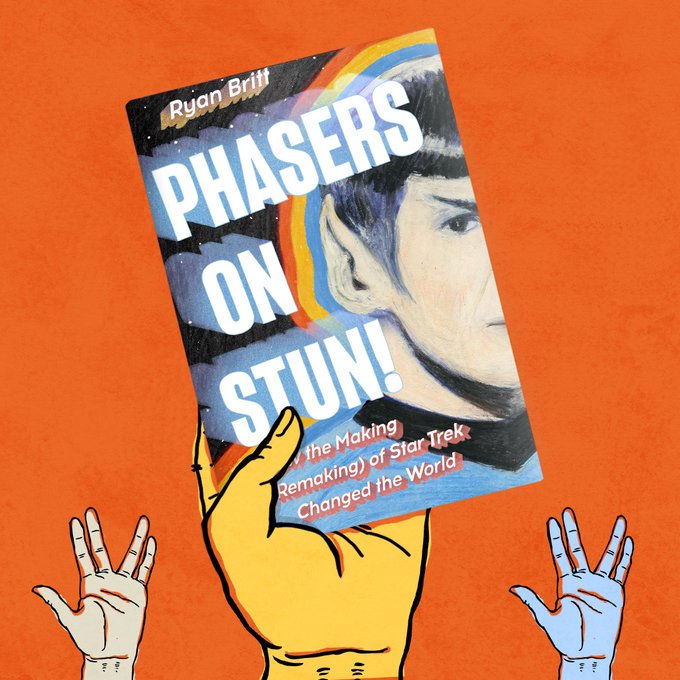
Plume The latest "Star Trek" book in the galaxy is "Phasers on Stun!"
After the 2021 release of “Luke Skywalker Can’t Read: And Other Geeky Truths,” a collection of off-the-cuff essays about a variety of sci-fi franchises, author Ryan Britt wanted to write something more focused for his second book. Since 2016, Britt told Heavy, he’d “done a decent amount of journalism on the newer ‘Star Trek‘ shows,” starting with “Discovery,” for various outlets. He liked the notion of those ideas and that reporting living on in book form, especially because he considers the internet “so ephemeral.” He contemplated several approaches for book two, he explained, and developed what he thought to be a fresh pitch: exploring the history of “Star Trek” through radical change.
The result is “Phasers on Stun!: How the Making (and Remaking) of Star Trek Changed the World,” out now from Plume. In essence, the book tracks the entire history of “Star Trek,” but in a personal, memoir-esque form. Heavy recently spoke with Britt about “Phasers on Stun!” During the conversation, he addressed his writing approach, securing interview subjects, his favorite episodes and movies, and more.
The Author Conducted More than 100 Interviews for ‘Phasers on Stun!’
What were some of the influences on “Phasers on Stun!?”
I was deeply influenced by Rob Sheffield’s 2017 book “Dreaming the Beatles.” I’m a huge fan of his, and to an extent, modeled “Luke Skywalker Can’t Read” on his essay collection “Talking to Girls About Duran Duran.” Though Chuck Klosterman’s “Sex, Drugs, and Cocoa Puffs” was probably the bigger influence on my first book, to be honest. Anyway, with “Dreaming the Beatles,” I felt that Rob really tackled something about which hundreds of books had been written, but somehow made the Beatles feel brand new. “Star Trek,” is to me, the Beatles of science-fiction. So, I suppose I felt like I wanted to do something like that. Create an aggressively mainstream, but also a very opinionated book about “Star Trek.”
Can you elaborate on that? What was your aim heading into it, and how did the book evolve as you wrote more and more of it?
I think my aim was to write a book for a mainstream audience that blew people away about just how radically different various aspects of “Star Trek” are from one another, and just how profound that it is. I also wanted to contrast “Star Trek” with almost any other pop-culture phenomenon. Like, people say the longevity of James Bond and “Star Wars” are similar to “Star Trek,” but, to me, that’s not true for so many different reasons. But, also because of my age — I was born in 1981 — I guess I wanted to do a “Star Trek” book from the point of view of “The Next Generation‘ Generation.” This isn’t to say I spend a disproportionate amount of time on “TNG” in the book. I don’t. But, I think it’s fair to say I’m a bit younger than most of the experts and journalists, and critics who have shaped some of the “Trek” discourse that has come before.
I suppose I wanted to push back on some dogma. Not refute facts, mind you, but perhaps focus on different aspects of “Trek” history, unburdened by the talking points other historians, authors, or documentarians have tended to focus on. To be clear, if someone is doing scholarly work and researching the origin of “The Original Series,” my book shouldn’t be used in place of an official book, like for example, the book (“Star Trek: The Original Series — A Celebration“) you did with Ben Robinson in 2021. My book isn’t an official book. It’s a book written by a critic and essayist about a topic. And because my book isn’t an official book, I get to be a little wilder, and I suppose, less comprehensive, by design.
What changed? That’s a big one, but I suppose what evolved as I wrote — and researched — was realizing which moments of change were actually more interesting to me. For example, I spent a lot of time chatting with Robin Curtis, who of course played Saavik in “Star Trek III: The Search For Spock,” and those interviews really changed the book. I mean, this is the only person in the history of “Star Trek” who played a Vulcan in a lead role and was cast and directed by Leonard Nimoy. I hope people let that sink in. I’ve noticed a general vibe in fandom that defaults to “Kirstie Alley was better,” sort of like a Roger Moore versus Sean Connery war of the Saaviks. But, I think Curtis is amazing as Saavik, and her position in “Trek” history — right as Nimoy is starting to take control of the actual narratives of the films — is super-interesting.
The Book is Part Memoir & Part Deep Dive into the History and Legacy of ‘Star Trek’
The end result is that “Phasers on Stun!” is part deep dive into “Star Trek” and its history and part memoir, examining your connection to “Star Trek” and what it has meant/means to you. How do you feel including yourself enhances the reader’s experience with the book?
My writing career started by publishing personal essays, not journalism. That happened later. And I became a non-fiction writer by telling stories on stage at The Moth in New York City in 2005, way before the podcast existed. So, that’s my style. Other writers do this a lot, too. Chuck Klosterman and Sarah Vowell are two of my writing heroes and their styles influenced my own. So, guess I don’t know any other way to write non-fiction in book form than the way I wrote this. To me, the whole advantage of doing a book of non-fiction is that I can drop the objective journalist guise.
Does that enhance the reader’s experience of the book? I don’t know. I’m sure certain kinds of hardcore fans will hate it. I’ve read a few reviews that were just like “This wasn’t as good as the ‘Fifty-Year Mission,'” or “I prefer the Marc Cushman books.” And that’s great. I mean, I love those books. And I interviewed Mark Altman and Marc Cushman for my book for a reason. I even cited stuff from your “Star Trek” book. There are academics and journalists like yourself, Sherilyn Connelly, Ed Gross, and Larry Nemecek, and think I stand on the shoulders of those people. But I’m also doing something different.
Who were you most excited to interview for “Phasers on Stun!” — and why?
Walter Koenig was extremely generous. He promised me 30 minutes and gave me way more than an hour. I mean, yes, I’ve interviewed Shatner twice, and aspects of both of those interviews are in the book. But, Koenig has the perfect balance of incisive perspective, but also, you know, respect for the nostalgia we all have. He’s not trying to burst your bubble, but he’s not going to lie to you either.
What were some of the surprises or tidbits you elicited from those people you spoke to that were new even to you?
Well, I guess everything I already mentioned about Robin Curtis, specifically the idea that Harve Bennett had sent her telegrams about “visiting the Vulcan obstetrician,” because Saavik was supposed to have Spock’s baby in “Star Trek IV.” I mean, she showed me the telegrams! That floored me. I’d heard rumors, I guess, but the reality of that felt very new.
You’re stuck alone on an island at sea with all the food and drink you need, and with ONE episode each of “TOS,” “TAS,” “TNG,” “DS9,” “VOY,” “ENT,” “DISCO,” “LD,” “Prodigy,” and “Strange New Worlds,” plus one “TOS” movie, one “TNG” movie, and one JJ-verse movie. Tell me the one of each you’d take and give me one sentence as to why.
“TOS:” “The Trouble With Tribbles.” I loved this episode as a kid. But then, as I got older, I kind of shunned it and even, at one point, claimed it was bad. But now, I have a 5-year-old daughter, and she loves this episode. As a result, I’ve rediscovered it. It’s funny, it’s well-paced, it’s utterly original and Shatner just cracks me up in it. “I have a ship to attend to, au revoir!”
“TAS:” “Yesteryear.” This is a classic for a reason. I can’t get over how good this episode is. The fact that it’s the first kids’ show that dealt with the death of a child’s pet just kills me.
“TNG:” “Encounter at Farpoint.” The themes laid out in “Encounter at Farpoint” hold up shockingly well. There’s a reason why Q was brought back so many times. I also think there’s a wonderful corniness to this episode that has aged better than some might say.
“DS9:” “Badda-Bing Badda-Bang.” I know I’m supposed to pick a heavier episode, but if it’s a desert island situation, I’m choosing this, because it’s both hilarious and a wonderfully hardcore science-fiction idea. Let’s save the reputation of this hologram nightclub owner, within a simulation? It’s so absurd. I love it.
“Voyager:” “Author, Author.” As someone who just pontificated quite a bit about the value of creative non-fiction and the need for authors to take liberties, it might be obvious why I love this episode. Tuvok fighting for the Doctor’s right to control his own art is wonderful. I want Tuvok to start a literary agency.
“Enterprise:” “A Night in Sickbay.” Come on. This episode is about Captain Archer’s dog peeing on an alien planet. The episode literally only happens because Archer lets his dog pee on an alien lawn.
“Discovery:” “Magic to Make the Sanest Man Go Mad.” Possibly Trek’s greatest Groundhog Day moment. I also think Rainn Wilson as Harry Mudd steals the show here. I love the waltz with Stamets and Burnham.
“Picard:” “Et in Arcadia Ego, Part 2.” I’ve come to realize, perhaps slowly, that I’m in a strange minority of fans and critics who adored “Picard” Season 1. I think if people have quibbles with the show overall, that’s one thing, but I’m not sure you can beat the dialogue in this season-one finale. Look, Michael Chabon is one of the greatest novelists alive. His dialogue really shines in this episode, especially in that final scene with Picard and Data.
“Lower Decks:” “No Small Parts.” I think this is one of the greatest season finales of “Star Trek,” ever. And yes, it is weird that it aired the same year that Riker appeared to save the day in the finale of “Picard,” in an episode I just mentioned. I guess, put me in the club that wants Riker to crash all the season finales. But really, I think this episode is dynamite.
“Prodigy:” “Kobayashi.” Beyond the “fan service” in this episode, I think there’s just something very sweet about it. Not sure I can put it any better than that. In some ways, I wish this episode had been a bit earlier in that first batch of “Prodigy” episodes.
“Strange New Worlds:” “Spock Amok.” Spock fighting a “human Spock” in a dream sequence is something I’ve thought about since I was 11 years old. On top of that, the “Freaky Friday” body switch with Spock and T’Pring is just handled so brilliantly.
“TOS” movie: “The Voyage Home.” This is one of the funniest movies of all time. Not just for a “Star Trek” movie, but for comedy movies in general. “I love Italian, and so do you.”
“TNG” movie: “Generations.” You’re supposed to say “First Contact.” But, again, desert island. I find “Generations” more comforting. I saw this movie perhaps 10 times in the theater, and I was certainly riding a bicycle to the theater many of those times because I was 13 years old in 1994. “Generations” is good.
Kelvin movie: “Star Trek Beyond.” I think this movie has a lot of heart and really fuses the sensibility of those reboot films with the spirit of “TOS.”
Actress Robin Curtis Showed Britt Proof that Saavik Was Supposed to be Pregnant in ‘Star Trek IV’

ParamountRobin Curtis and Jane Wyatt in a scene from “Star Trek IV: The Voyage Home.”
The subtitle of “Phasers on Stun!” is “How the Making (and Remaking) of Star Trek Changed the World.” At the end of the day, in what ways has “Star Trek” actually changed the world?
The short answer: Mainstream science-fiction and geek culture would not exist in the way it does today, not even close, without “Star Trek” paving the way. Imagine there’s no “Star Wars,” and the reason why is because there was no “Star Trek.” George Lucas actually has said that! “TOS” writer Norman Spinrad said it best when I interviewed him for the book; “Star Trek” was like the sci-fi moment of Bob Dylan going electric. Nothing made sci-fi more accessible in the 60s and 70s than “Star Trek.” And, in some ways, that was true of the ’90s, too. I mean, other than “The X-Files,” was there a truly mainstream sci-fi show in the ’90s? You can forget the MCU and all these really self-important prestige sci-fi shows like “Westworld” or whatever. None of that exists without “Star Trek.” None of it. I mean, look at “Star Wars” now! It’s on TV!
If you write a sequel to “Phasers on Stun!’ in 5 years, what do you imagine you’d be exploring/addressing in that book?
Hmm. Well, I’m not sure I’m itching to do another non-fiction book about “Star Trek” in five years. I do hope that my publisher will consider doing a paperback of “Phasers On Stun!” in 2024 or later, and then I can update and revise the book with a bunch more from “Strange New Worlds,” “Lower Decks,” “Prodigy,” and “Picard.” Also, the book has just come out in hardcover, so it’s hard to think too far ahead. Plus, I’m working on a non-fiction book about “Dune, “which comes out in Fall 2023. So right now, I’m just focused on “The Spice Must Flow, “which is the “Dune” book, and after that, I have two different novels I want to get published, neither of which are quite science-fiction novels. Frankly, if I do a “Star Trek” book in 5 years, I actually hope it’s a novel! I feel like I could write a killer “Star Trek” novel, or 10. I’d love to write a “Star Trek” novel that broke through to the mainstream, and was like, somehow, viewed as a regular novel.
“Phasers on Stun!: How the Making (and Remaking) of Star Trek Changed the World” is available now from Plume.

Comments
New Book Explores ‘Star Trek’ History through the Prism of Radical Change